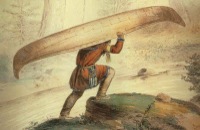Difference between revisions of "Portage"
m (Text replacement - "http://nordan.daynal.org" to "https://nordan.daynal.org") |
m (Text replacement - "http://" to "https://") |
||
| Line 3: | Line 3: | ||
==Origin== | ==Origin== | ||
[https://nordan.daynal.org/wiki/index.php?title=English#ca._1100-1500_.09THE_MIDDLE_ENGLISH_PERIOD Middle English], from Anglo-French, from ''porter'' to carry | [https://nordan.daynal.org/wiki/index.php?title=English#ca._1100-1500_.09THE_MIDDLE_ENGLISH_PERIOD Middle English], from Anglo-French, from ''porter'' to carry | ||
| − | *[ | + | *[https://en.wikipedia.org/wiki/19th_century 1836] |
==Definitions== | ==Definitions== | ||
*1: the labor of carrying or [[transporting]] | *1: the labor of carrying or [[transporting]] | ||
| Line 12: | Line 12: | ||
'''Portage''' or portaging is the [[practice]] of carrying water craft or cargo over [[land]], either around an [[obstacle]] in a [[river]], or between two bodies of water. A place where this carrying occurs is also called a ''portage''. | '''Portage''' or portaging is the [[practice]] of carrying water craft or cargo over [[land]], either around an [[obstacle]] in a [[river]], or between two bodies of water. A place where this carrying occurs is also called a ''portage''. | ||
| − | Early French explorers in [ | + | Early French explorers in [https://en.wikipedia.org/wiki/New_France New France] and French Louisiana encountered many rapids and cascades. The [https://en.wikipedia.org/wiki/Amerindian Amerindians] carried their canoes over land to avoid river [[obstacles]]. |
| − | Over time, important portages were sometimes provided with [ | + | Over time, important portages were sometimes provided with [https://en.wikipedia.org/wiki/Canal canals] with [https://en.wikipedia.org/wiki/Canal_lock locks], and even [https://en.wikipedia.org/wiki/Portage_railway portage railways]. [[Primitive]] portaging generally involves carrying the vessel and its contents across the portage in multiple trips. Small canoes can be portaged by carrying them inverted over one's shoulders and the center strut may be designed in the style of a [[yoke]] to [[facilitate]] this. Historically, [https://en.wikipedia.org/wiki/Voyageurs voyageurs] often employed a [https://en.wikipedia.org/wiki/Tump_line tump line] on their head to carry a load on their back. |
| − | Portages can be many kilometers in length, such as the 19-kilometre (12 mi) [ | + | Portages can be many kilometers in length, such as the 19-kilometre (12 mi) [https://en.wikipedia.org/wiki/Methye_Portage Methye Portage] and the 8.5-mile (13.7 km) [https://en.wikipedia.org/wiki/Grand_Portage_National_Monument Grand Portage], both in North America) and often cover hilly or difficult terrain. Some portages involve very little elevation change, such as the very short [https://en.wikipedia.org/wiki/Mavis_Grind Mavis Grind] in Shetland, which crosses an isthmus.[https://en.wikipedia.org/wiki/Portage] |
[[Category: General Reference]] | [[Category: General Reference]] | ||
Latest revision as of 02:26, 13 December 2020
Origin
Middle English, from Anglo-French, from porter to carry
Definitions
- 1: the labor of carrying or transporting
- 2archaic : the cost of carrying : porterage
- 3a : the carrying of boats or goods overland from one body of water to another or around an obstacle (as a rapids)
- b : the route followed in making such a transfer
Description
Portage or portaging is the practice of carrying water craft or cargo over land, either around an obstacle in a river, or between two bodies of water. A place where this carrying occurs is also called a portage.
Early French explorers in New France and French Louisiana encountered many rapids and cascades. The Amerindians carried their canoes over land to avoid river obstacles.
Over time, important portages were sometimes provided with canals with locks, and even portage railways. Primitive portaging generally involves carrying the vessel and its contents across the portage in multiple trips. Small canoes can be portaged by carrying them inverted over one's shoulders and the center strut may be designed in the style of a yoke to facilitate this. Historically, voyageurs often employed a tump line on their head to carry a load on their back.
Portages can be many kilometers in length, such as the 19-kilometre (12 mi) Methye Portage and the 8.5-mile (13.7 km) Grand Portage, both in North America) and often cover hilly or difficult terrain. Some portages involve very little elevation change, such as the very short Mavis Grind in Shetland, which crosses an isthmus.[1]
